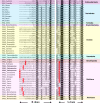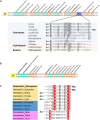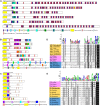Identification and Characterization of Neuropeptides by Transcriptome and Proteome Analyses in a Bivalve Mollusc Patinopecten yessoensis
- PMID: 29922332
- PMCID: PMC5996578
- DOI: 10.3389/fgene.2018.00197
Identification and Characterization of Neuropeptides by Transcriptome and Proteome Analyses in a Bivalve Mollusc Patinopecten yessoensis
Abstract
Neuropeptides play essential roles in regulation of reproduction and growth in marine molluscs. But their function in marine bivalves - a group of animals of commercial importance - is largely unexplored due to the lack of systematic identification of these molecules. In this study, we sequenced and analyzed the transcriptome of nerve ganglia of Yesso scallop Patinopecten yessoensis, from which 63 neuropeptide genes were identified based on BLAST and de novo prediction approaches, and 31 were confirmed by proteomic analysis using the liquid chromatography-tandem mass spectrometry (LC-MS/MS). Fifty genes encode known neuropeptide precursors, of which 20 commonly exist in bilaterians and 30 are protostome specific. Three neuropeptides that have not yet been reported in bivalves were identified, including calcitonin/DH31, lymnokinin and pleurin. Characterization of glycoprotein hormones, insulin-like peptides, allatostatins, RFamides, and some reproduction, cardioactivity or feeding related neuropeptides reveals scallop neuropeptides have conserved molluscan neuropeptide domains, but some (e.g., GPB5, APGWamide and ELH) are characterized with bivalve-specific features. Thirteen potentially novel neuropeptides were identified, including 10 that may also exist in other protostomes, and 3 (GNamide, LRYamide, and Vamide) that may be scallop specific. In addition, we found neuropeptides potentially related to scallop shell growth and eye functioning. This study represents the first comprehensive identification of neuropeptides in scallop, and would contribute to a complete understanding on the roles of various neuropeptides in endocrine regulation in bivalve molluscs.
Keywords: bivalve mollusc; cardioactivity; eye functioning; ganglia transcriptome; mass spectrometry; neuropeptide; reproduction; shell growth.
Figures






Similar articles
-
Evolution and Potential Function in Molluscs of Neuropeptide and Receptor Homologues of the Insect Allatostatins.Front Endocrinol (Lausanne). 2021 Sep 29;12:725022. doi: 10.3389/fendo.2021.725022. eCollection 2021. Front Endocrinol (Lausanne). 2021. PMID: 34659116 Free PMC article.
-
Characterization of the mantle transcriptome of yesso scallop (Patinopecten yessoensis): identification of genes potentially involved in biomineralization and pigmentation.PLoS One. 2015 Apr 9;10(4):e0122967. doi: 10.1371/journal.pone.0122967. eCollection 2015. PLoS One. 2015. PMID: 25856556 Free PMC article.
-
Somatostatin Receptor Gene Functions in Growth Regulation in Bivalve Scallop and Clam.Int J Mol Sci. 2024 Apr 28;25(9):4813. doi: 10.3390/ijms25094813. Int J Mol Sci. 2024. PMID: 38732036 Free PMC article.
-
Evolution and Comparative Physiology of Luqin-Type Neuropeptide Signaling.Front Neurosci. 2020 Feb 18;14:130. doi: 10.3389/fnins.2020.00130. eCollection 2020. Front Neurosci. 2020. PMID: 32132900 Free PMC article. Review.
-
p53 Superfamily proteins in marine bivalve cancer and stress biology.Adv Mar Biol. 2011;59:1-36. doi: 10.1016/B978-0-12-385536-7.00001-7. Adv Mar Biol. 2011. PMID: 21724017 Review.
Cited by
-
Identification and characterization of gonadotropin-releasing hormone (GnRH) in Zhikong scallop Chlamys farreri during gonadal development.Front Physiol. 2023 May 31;14:1180725. doi: 10.3389/fphys.2023.1180725. eCollection 2023. Front Physiol. 2023. PMID: 37324384 Free PMC article.
-
Extensive conservation of the proneuropeptide and peptide prohormone complement in mollusks.Sci Rep. 2019 Mar 19;9(1):4846. doi: 10.1038/s41598-019-40949-0. Sci Rep. 2019. PMID: 30890731 Free PMC article.
-
Molecular and functional characterization of somatostatin-type signalling in a deuterostome invertebrate.Open Biol. 2020 Sep;10(9):200172. doi: 10.1098/rsob.200172. Epub 2020 Sep 9. Open Biol. 2020. PMID: 32898470 Free PMC article.
-
A nemertean excitatory peptide/CCHamide regulates ciliary swimming in the larvae of Lineus longissimus.Front Zool. 2019 Jul 10;16:28. doi: 10.1186/s12983-019-0326-9. eCollection 2019. Front Zool. 2019. PMID: 31333754 Free PMC article.
-
Evolution and Potential Function in Molluscs of Neuropeptide and Receptor Homologues of the Insect Allatostatins.Front Endocrinol (Lausanne). 2021 Sep 29;12:725022. doi: 10.3389/fendo.2021.725022. eCollection 2021. Front Endocrinol (Lausanne). 2021. PMID: 34659116 Free PMC article.
References
-
- Abdraba A. M., Saleuddin A. S. (2000). Protein synthesis in vitro by mantle tissue of the land snail Otala lactea: possible insulin-like peptide function. Can. J. Zool. 78 1527–1535. 10.1139/z00-030 - DOI
LinkOut - more resources
Full Text Sources
Other Literature Sources
Research Materials

